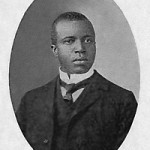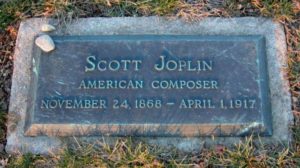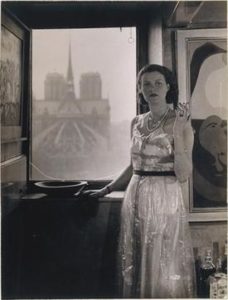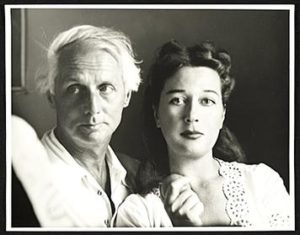 On this day in 1917, composer and pianist, The King of Ragtime, Scott Joplin died from tertiary syphilis and a resulting descent into insanity, in Manhattan State Hospital, a mental institution at the age of 49. During his brief career, he wrote 44 original ragtime pieces, one ragtime ballet, and two operas. One of his first pieces, the Maple Leaf Rag, became ragtime’s first and most influential hit, and has been recognized as the archetypal rag. Joplin was born into a musical family of laborers in Northeast Texas. He grew up in Texarkana, where he formed a vocal quartet, and taught mandolin and guitar. Joplin began publishing music in 1895, and publication of his Maple Leaf Rag in 1899 brought him fame. The score to his first opera, A Guest of Honor, was confiscated in 1903 with his belongings, owing to his non-payment of bills, and is considered lost. He continued to compose and publish music, and in 1907 moved to New York City, seeking to find a producer for a new opera. Joplin never married.
On this day in 1917, composer and pianist, The King of Ragtime, Scott Joplin died from tertiary syphilis and a resulting descent into insanity, in Manhattan State Hospital, a mental institution at the age of 49. During his brief career, he wrote 44 original ragtime pieces, one ragtime ballet, and two operas. One of his first pieces, the Maple Leaf Rag, became ragtime’s first and most influential hit, and has been recognized as the archetypal rag. Joplin was born into a musical family of laborers in Northeast Texas. He grew up in Texarkana, where he formed a vocal quartet, and taught mandolin and guitar. Joplin began publishing music in 1895, and publication of his Maple Leaf Rag in 1899 brought him fame. The score to his first opera, A Guest of Honor, was confiscated in 1903 with his belongings, owing to his non-payment of bills, and is considered lost. He continued to compose and publish music, and in 1907 moved to New York City, seeking to find a producer for a new opera. Joplin never married.
 The Final Footprint – Joplin was buried in a pauper’s grave that remained unmarked for 57 years. His grave at Saint Michaels Cemetery in East Elmhurst, New York, was finally given a marker in 1974. Joplin’s death is widely considered to mark the end of ragtime as a mainstream music format, and in the next several years it evolved with other styles into jazz, and eventually big band swing. His music was rediscovered and returned to popularity in the early 1970s with the release of a million-selling album of Joplin’s rags recorded by Joshua Rifkin, followed by the Academy Award–winning movie The Sting, which featured several of his compositions, such as The Entertainer. The opera Treemonisha was finally produced in full to wide acclaim in 1972. In 1976, Joplin was posthumously awarded a Pulitzer Prize.
The Final Footprint – Joplin was buried in a pauper’s grave that remained unmarked for 57 years. His grave at Saint Michaels Cemetery in East Elmhurst, New York, was finally given a marker in 1974. Joplin’s death is widely considered to mark the end of ragtime as a mainstream music format, and in the next several years it evolved with other styles into jazz, and eventually big band swing. His music was rediscovered and returned to popularity in the early 1970s with the release of a million-selling album of Joplin’s rags recorded by Joshua Rifkin, followed by the Academy Award–winning movie The Sting, which featured several of his compositions, such as The Entertainer. The opera Treemonisha was finally produced in full to wide acclaim in 1972. In 1976, Joplin was posthumously awarded a Pulitzer Prize.
#RIP #OTD in 1965 businesswoman, art collector, philanthropist, cosmetics entrepreneur, founder of Helena Rubinstein Inc., Helena Rubinstein died in New York City aged 94. Mount Olivet Cemetery in Queens
| Max Ernst | |
|---|---|
 1920, Punching Ball ou l’Immortalité de Buonarroti, photomontage, gouache, ink on photograph (self-portrait) |
|
On this day in 1976 painter, sculptor, poet Max Ernst died at the age of 84 in Paris. Born in Brühl, German Empire on 2 April 1891. A prolific artist, Ernst was a primary pioneer of the Dada movement and Surrealism.

Ubu Imperator, (1923), Musee National d’Art Moderne, Centre Pompidou, Paris, France
In 1918 he married art history student Luise Straus, whom he had met in 1914. Ernst’s marriage to Luise was short-lived. In 1921 he met Paul Éluard, who became a close lifelong friend. Éluard bought two of Ernst’s paintings (Celebes and Oedipus Rex) and selected six collages to illustrate his poetry collection Répétitions. A year later the two collaborated on Les malheurs des immortels, and then with André Breton, whom Ernst met in 1921, on the magazine Littérature. In 1922, unable to secure the necessary papers, Ernst entered France illegally and settled into a ménage à trois with Éluard and his wife Gala in Paris suburb Saint-Brice, leaving behind his wife and son.
In 1924 Éluard left, first for Monaco, and then for Saigon, Vietnam. He soon asked his wife and Ernst to join him. After a brief time together in Saigon, the trio decided that Gala would remain with Paul. The Éluards returned to Eaubonne in early September, while Ernst followed them some months later. He returned to Paris in late 1924 and established a studio at 22, rue Tourlaque.
 In 1927 Ernst married Marie-Berthe Aurenche, and it is thought his relationship with her may have inspired the erotic subject matter of The Kiss and other works of that year. Ernst appeared in the 1930 film L’Âge d’Or, directed by self-identifying Surrealist Luis Buñuel. In 1938, the American heiress and artistic patron Peggy Guggenheim acquired a number of Ernst’s works, which she displayed in her new gallery in London. Ernst and Guggenheim later were married (1942–1946).
In 1927 Ernst married Marie-Berthe Aurenche, and it is thought his relationship with her may have inspired the erotic subject matter of The Kiss and other works of that year. Ernst appeared in the 1930 film L’Âge d’Or, directed by self-identifying Surrealist Luis Buñuel. In 1938, the American heiress and artistic patron Peggy Guggenheim acquired a number of Ernst’s works, which she displayed in her new gallery in London. Ernst and Guggenheim later were married (1942–1946).

L’Ange du Foyer, (1937)

Peggy Guggenheim, c.1930, Paris, photograph Rogi André (Rozsa Klein). In the background, Notre Dame de Paris, and on the right, Joan Miró, Dutch Interior II (1928).
In September 1939, the outbreak of World War II caused Ernst to be interned as an “undesirable foreigner” in Camp des Milles, near Aix-en-Provence. At the time, he was living with his lover and fellow surrealist painter, Leonora Carrington who, not knowing whether he would return, saw no option but to sell their house to repay their debts and leave for Spain. Thanks to the intercession of Éluard and other friends, he was released a few weeks later. Soon after the German occupation of France, he was arrested again, this time by the Gestapo, but managed to escape and flee to America with the help of Guggenheim and friends. Ernst and Guggenheim arrived in the United States in 1941 and were married at the end of the year.
His marriage to Guggenheim did not last and in Beverly Hills, California in October 1946, in a double ceremony with Man Ray and Juliet P. Browner, he married Dorothea Tanning.

Ernst and Tanning
The couple made their home in Sedona, Arizona from 1946 to 1953, where the high desert landscapes inspired them and recalled Ernst’s earlier imagery. Despite the fact that Sedona was remote and populated by fewer than 400 ranchers, orchard workers, merchants and small Native American communities, their presence helped begin what would become an American artists colony. Among the monumental red rocks, Ernst built a small cottage by hand on Brewer Road and he and Tanning hosted intellectuals and European artists such as Henri Cartier-Bresson. Sedona proved an inspiration for the artists and for Ernst, who compiled his book Beyond Painting and completed his sculptural masterpiece Capricorn while living there. From the 1950s he lived mainly in France.
 The Final Footprint
The Final Footprint
Père Lachaise Cemetery in Paris. Other notable Final Footprints at Père Lachaise include; Guillaume Apollinaire, Honoré de Balzac, Jean-Dominique Bauby, Georges Bizet, Maria Callas, Chopin, Colette, Auguste Comte, Jean-Baptiste-Camille Corot, Molière, Jim Morrison, Édith Piaf, Camille Pissarro, Marcel Proust, Sully Prudhomme, Gioachino Rossini, Georges-Pierre Seurat, Simone Signoret, Gertrude Stein, Dorothea Tanning, Alice B. Toklas, Oscar Wilde, and Richard Wright.
- Etna
- Grave-digger
- at your post for thirty years
- like Jesus Christ
- you seldom grant yourself…
- fully content with a little exercise
- exercise makes you strong
- I like you
-
- first couplet of his poem ‘Etna’, in: ‘Literature’, Paris, October 15, 1923; as quoted in Max Ernst sculpture, Museo d’arte contemporanea, Edizioni Charta, Milano, 1969, p. 15
- What is a dream? You ask too much of me: it is a woman cutting down a tree. What are forests for? For making the matches one gives children to play with. Is the fire in the forest, then? The fire is in the forest. What do plants feed on? On mystery. What day is it today? Shit..
- A painter may know what he doesn’t want. But woe be to him if he desires to know what he wants. A painter is lost if he finds himself. Max Ernst considers his sole virtue to be that he has managed not to find himself.
- In Beyond Painting, Max Ernst, 1948, p.14; as quoted in Max Ernst: a Retrospective, ed. Werner Spies & Sabine Rewald, Metropolitan Museum of Art, New York 2005, p. 6
- Woman’s nakedness is wiser than the teachings of the philosophers. [the title of his essay]
- In: Max Ernst, Gonthier-Seghers, Paris, 1959; as quoted in Max Ernst sculpture, Museo d’arte contemporanea. Edizioni Charta, Milano, 1996, p. 37
- A painter may know what he does not want.
- But woe betide him if he wants to know
- what he does want! A painter is lost if he finds himself.
- The fact that he has succeeded in not finding
- himself is regarded by Max Ernst as his only
- ‘achievement’.
- Max Ernst in ‘Max Ernst’, exhibition catalogue, Galerie Stangl, Munich, 1967, U.S., pp.6-7, as quoted in Edward Quinn, Max Ernst. 1984, Poligrafa, Barcelona. p. 12
‘Ecritures’ (1970)
- ‘Écritures’ pp. 221, 223., as quoted in Max Ernst, Edward Quinn, Poligrafa, Barcelona, 1984,
- Eternity
- Hide yourself
- eternity
- beloved eternity
- p.290
- The painter
- The painter allows you not to know
- what a face is
- Escaped from the museum of man,
- he has chosen to e mortal!
- Mortal like
- the kiss of the Mona Lisa
- p. 352
- Laymanship
- Don’t confuse
- the fairy’s kiss
- with
- the priest’s spanking
- p. 360
- Sanctuary
All windows fall silent The earth closes its eyes
- p. 366
 On this day in 1984, singer-songwriter and musician, The Prince of Motown, The Prince of Soul, Grammy winner, Marvin Gaye was shot and killed by his father during an argument at his parent’s home in Los Angeles the day before his 45th birthday. Born Marvin Pentz Gaye, Jr. on 2 April 1939 at Freedman’s Hospital in Washington, D.C. One of the giants of music. Where does one start a list of favorite Gaye songs; “Can I get a Witness”, “What’s Going On”, “Let’s Get it On”, “Sexual Healing”, to name just a few. Gaye was married twice; Anna Gordy, Berry Gordy’s sister (1964-1977) and Janis Hunter (1977-1981 divorce).
On this day in 1984, singer-songwriter and musician, The Prince of Motown, The Prince of Soul, Grammy winner, Marvin Gaye was shot and killed by his father during an argument at his parent’s home in Los Angeles the day before his 45th birthday. Born Marvin Pentz Gaye, Jr. on 2 April 1939 at Freedman’s Hospital in Washington, D.C. One of the giants of music. Where does one start a list of favorite Gaye songs; “Can I get a Witness”, “What’s Going On”, “Let’s Get it On”, “Sexual Healing”, to name just a few. Gaye was married twice; Anna Gordy, Berry Gordy’s sister (1964-1977) and Janis Hunter (1977-1981 divorce).
The Final Footprint – Gaye was cremated and his cremains were scattered in the Pacific Ocean.
#RIP #OTD in 1991 modern dancer and choreographer, the Picasso of Dance, Martha Graham died in New York City from pneumonia, aged 96. Cremated remains scattered over the Sangre de Cristo Mountains in northern New Mexico
#RIP #OTD in 2004 actress (Diary of a Mad Housewife, Pale Rider), Neil Young muse, Carrie Snodgress died of heart failure while waiting for a liver transplant in Los Angeles, aged 58. Forest Lawn Memorial Park Glendale, California
Have you planned yours yet?
Follow TFF on twitter @RIPTFF

